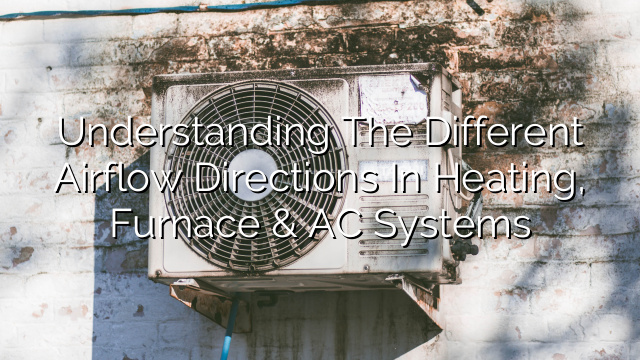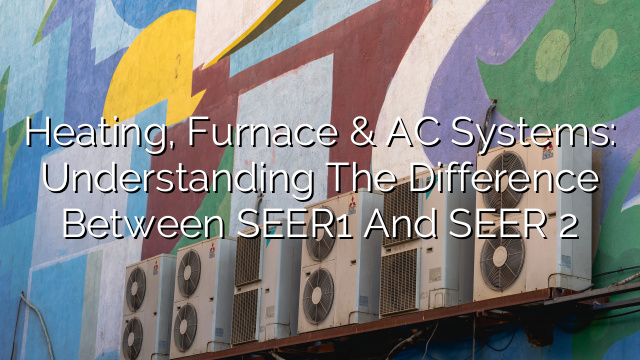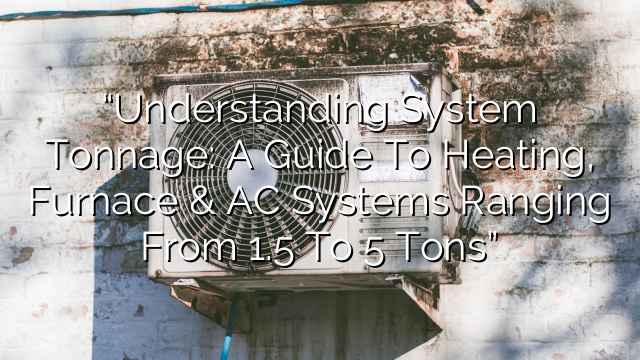Introduction
When it comes to heating, furnace, and AC systems, understanding the different airflow directions is crucial. There are three main types of airflow directions in these systems: upflow, horizontal, and downflow. Each direction has its own unique advantages and disadvantages, and it’s important to know which one is right for your home. In this blog post, we will explain the different airflow directions and help you make an informed decision about your heating, furnace, and AC system.
Upflow Airflow Direction
Upflow airflow direction refers to when the air in your heating, furnace, or AC system flows upwards. This type of airflow is commonly found in basement installations. The advantage of upflow airflow direction is that it helps to keep your living space warm in the winter and cool in the summer. This is because warm air naturally rises, making it easier to distribute heat evenly throughout your home.
However, there are some downsides to upflow airflow direction. One disadvantage is that it can be more difficult to install and maintain than other airflow directions. Additionally, if you have a basement that is prone to dampness or flooding, an upflow system may not be the best option for you.
Horizontal Airflow Direction
Horizontal airflow direction refers to when the air in your heating, furnace, or AC system flows horizontally. This type of airflow is commonly found in attics or crawl spaces. The advantage of horizontal airflow direction is that it is often the easiest and most cost-effective to install. It also allows for flexible installation options, as the system can be placed in a variety of locations.
However, there are some downsides to horizontal airflow direction as well. One disadvantage is that it may not distribute heat or cool air as evenly as other airflow directions. This is because warm air does not naturally rise or cool air does not naturally sink, so maintaining a consistent temperature throughout your home can be more challenging.
Downflow Airflow Direction
Downflow airflow direction refers to when the air in your heating, furnace, or AC system flows downwards. This type of airflow is commonly found in attic installations. The advantage of downflow airflow direction is that it can be more efficient at cooling your home in the summer. This is because cool air naturally sinks, making it easier to distribute cool air evenly throughout your home.
However, there are also some downsides to downflow airflow direction. One disadvantage is that it can be more difficult to distribute heat evenly in the winter. This is because warm air does not naturally sink, so you may need additional measures such as ceiling fans or ductwork modifications to ensure that heat is evenly distributed throughout your home.
Which Airflow Direction is Right for You?
Now that you understand the different airflow directions in heating, furnace, and AC systems, how do you determine which one is right for your home? It ultimately depends on your specific needs and the layout of your home.
If your basement is prone to dampness or flooding, an upflow system may not be the best option for you. On the other hand, if you have limited space and want a cost-effective installation, a horizontal system may be the way to go. Finally, if you prioritize efficient cooling in the summer, a downflow system may be the best choice for you.
It’s also important to consult with a professional HVAC technician who can assess your home’s needs and recommend the most suitable airflow direction for your heating, furnace, and AC system.
FAQ
- Can I change the airflow direction of my existing heating or AC system? In most cases, yes. However, it’s recommended to consult with a professional HVAC technician to assess the feasibility of such a change and to ensure that it is done properly.
- How can I determine the current airflow direction of my heating or AC system? The best way to determine the airflow direction of your system is to consult the manufacturer’s documentation or the specifications provided by the HVAC technician who installed your system. If you’re unable to find this information, a professional HVAC technician can assist you in determining the airflow direction.
- What other factors should I consider when choosing a heating, furnace, or AC system? In addition to airflow direction, you should also consider factors such as energy efficiency, size and capacity of the system, noise level, and maintenance requirements. Consulting with a professional HVAC technician can help you make an informed decision based on your specific needs and budget.
- Can I install a different airflow direction system than what I currently have? Yes, it is possible to install a different airflow direction system than what you currently have. However, this may require modifications to your existing ductwork or installation of additional components. It’s best to consult with a professional HVAC technician to assess the feasibility of such a change and to ensure that it is done properly.














